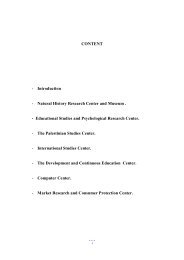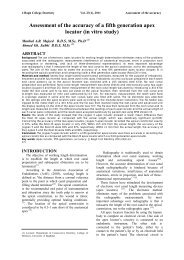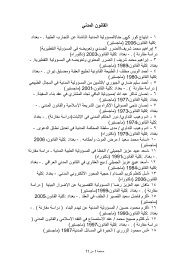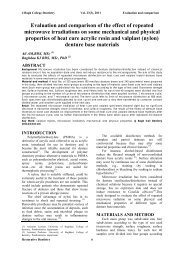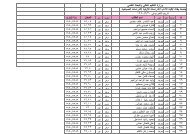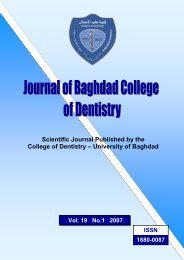Polymeric Membrane Sensors for The Selective Determination of ...
Polymeric Membrane Sensors for The Selective Determination of ...
Polymeric Membrane Sensors for The Selective Determination of ...
You also want an ePaper? Increase the reach of your titles
YUMPU automatically turns print PDFs into web optimized ePapers that Google loves.
E(mV)<br />
Iraqi J Pharm Sci, Vol.21(1) 2012<br />
<strong>Polymeric</strong> membrane sensors and pharmaceutical analysis<br />
powdered, well mixed and an accurate weight<br />
required to prepare 10 -3 M MCP hydrochloride<br />
solution was dissolved in a minimum amount<br />
<strong>of</strong> double distilled water, filtered into a 25 ml<br />
volumetric flask and diluted to the mark.<br />
Injection ampoules (placeela), oral pediatric<br />
drops (meclodin) and syrup (clopram): an<br />
accurate volumes (12 ml, 7.5 ml, 30 ml) <strong>of</strong><br />
each <strong>for</strong>mulation respectively were<br />
quantitatively and separately transferred into<br />
100 ml volumetric flasks and the volumes were<br />
completed to the mark with double distilled<br />
water to get solutions <strong>of</strong> 10 -3 M MCP<br />
hydrochloride. As pure and pharmaceutical<br />
samples: a 20 ml aliquot <strong>of</strong> the drug solution<br />
was potentiometrically measured as described<br />
and the potential reading was compared with<br />
the calibration plot. Alternatively the standard<br />
addition method was applied by measuring the<br />
potentials <strong>of</strong> the drug test solution be<strong>for</strong>e and<br />
after the addition <strong>of</strong> small increments (0.2 ml)<br />
<strong>of</strong> a standard solution (10 -1 M) <strong>of</strong> MCP<br />
hydrochloride. <strong>The</strong> change in the electrode<br />
potential (E) at constant temperature <strong>of</strong> 25C<br />
was recorded and used to calculate the<br />
concentration <strong>of</strong> the drug. (21) A potentiometric<br />
titration was also applied when 10 mL aliquot<br />
<strong>of</strong> the drug test solution were diluted to 100 ml<br />
with double distilled water. <strong>The</strong> resultant<br />
solution was titrated with (10 -2 and 10 -3 M)<br />
standard solution <strong>of</strong> PT using MCP membrane<br />
electrode as the sensor.<br />
Results and Discussion<br />
<strong>Membrane</strong> composition and electrode<br />
response<br />
metoclopramide hydrochloride<br />
phosphotungstate is a stable water insoluble<br />
ion pair complex but readily soluble in organic<br />
solvents such as tetrahydr<strong>of</strong>uran. <strong>The</strong> complex<br />
was dispersed in a PVC membrane as an active<br />
material with the following plasticizers:<br />
tributyl phosphate (TBP), dioctyl phenyl<br />
phosphonate (DOPP), dibutyl phthalate<br />
(DBPH), dioctyl phthalate (DOP), dibutyl<br />
phosphate (DBP) and bis(2-ethyl-hexyl<br />
phosphate) (BEHP). <strong>The</strong> per<strong>for</strong>mance<br />
characteristics <strong>of</strong> the proposed sensors based<br />
on data collected over a period <strong>of</strong> nine weeks<br />
were evaluated according to IUAPC<br />
recommendations. (22) <strong>The</strong> results were<br />
summarized in Table 1. A typical calibration<br />
graph <strong>of</strong> MCP sensors is shown in Figure1. It<br />
is well known that the nature <strong>of</strong> the plasticizer<br />
significantly influence the sensitivity, linearity<br />
and life time <strong>of</strong> the polymeric membrane<br />
sensors. <strong>The</strong> plasticizers insured the mobility<br />
<strong>of</strong> the membrane constituents within the<br />
membrane phase by lowering the viscosity <strong>of</strong><br />
the polymer matrix, set the dielectric constant<br />
<strong>of</strong> the membrane phase and provide a suitable<br />
mechanical properties <strong>of</strong> the membrane. (23,24)<br />
Non- Nernstian slopes were obtained with<br />
sensors depending on DBP and BEHP. <strong>The</strong>ir<br />
slopes were (40.7 and 29.0) mV/decade with<br />
correlation coefficients <strong>of</strong> 0.9982 and 0.9979<br />
respectively. <strong>The</strong> linear range <strong>of</strong> concentration<br />
were 1.0×10 -4 - 1.0×10 -2 M and 6.0×10 -4 -<br />
5.0×10 -2 M with detection limits 4.0×10 -5 M<br />
and 2.0×10 -4 M respectively. <strong>The</strong> poor results<br />
<strong>for</strong> sensors using DBP and BEHP can be<br />
attributed to the low solubility or low<br />
distribution <strong>of</strong> MCP-PT ion pair in these<br />
plasticizers that have high viscosity (112.89<br />
and 272.54) cST. On the other hand the<br />
membranes based on DOPP, DBPH and DOP<br />
gave a near Nernstian slopes <strong>of</strong> (57.7, 57.4 and<br />
55.3) mV/decade with correlation coefficients<br />
<strong>of</strong> 0.9996, 0.9996 and 0.9986 respectively. <strong>The</strong><br />
linear range <strong>of</strong> these membranes were 1.0×10 -5<br />
- 1.0×10 -2 M <strong>for</strong> membranes using DOPP and<br />
DBPH, and 3.0×10 -5 - 1.0×10 -2 M <strong>for</strong> DOP<br />
with detection limits <strong>of</strong> 4.0×10 -6 M, 4.0×10 -6 M<br />
and 6.0×10 -6 M respectively. A Nernstian slope<br />
<strong>of</strong> 59.9 mV/decade with correlation coefficient<br />
<strong>of</strong> 0.9998 was obtained <strong>for</strong> membrane based<br />
on TBP and a linear concentration range<br />
1.0×10 -5 - 1.0×10 -2 M and detection limit<br />
3.0×10 -6 M. <strong>The</strong> stability <strong>of</strong> electrodes was<br />
monitored continuously by measuring the<br />
potential drift and evaluate it <strong>for</strong> a period <strong>of</strong> 15<br />
days. <strong>The</strong> standard deviations <strong>of</strong> the potential<br />
drift obtained <strong>for</strong> these 15 days were ± 1, ± 1,<br />
± 1, ± 4, ± 9 and ± 12 mV <strong>for</strong> membranes No.<br />
I, II, III, IV, V and VI respectively.<br />
250<br />
200<br />
150<br />
100<br />
50<br />
0<br />
-5 0<br />
TBP<br />
DOPP<br />
DBPH<br />
DOP<br />
-1 00<br />
1.0E-7 1.0E-6 1.0E-5 1.0E-4 1.0E-3 1.0E-2 1.0E-1 1.0E+0<br />
concentration <strong>of</strong> MCP (M)<br />
Figure 1: Calibration curves <strong>of</strong><br />
metoclopramide hydrochloride electrode<br />
72



